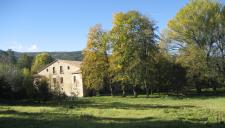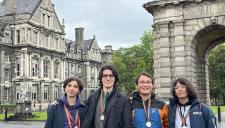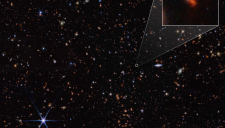According to a study by the cosmologist Andrea Ferrara and his research team at the Scuola Normale, the blue colours - and not red, as would be expected – of the giant galaxies imaged by the James Webb space telescope is caused by the galactic super winds that have swept away the dust and gases that surrounded them at the dawn of the Universe. The study has been published in the British journal Monthly Notices of the Royal Astronomical Society.
PISA, 09 May 2023. Among the more sensational discoveries of the James Webb Space Telescope, the largest space telescope ever built, in orbit since Christmas Day 2021, is undoubtedly the surprising abundance of giant galaxies, which already contain up to a billion stars like the Sun in the early Universe: a period that astrophysicists call the cosmic dawn, more than 13 billion light years away from us. Not only are these galaxies huge, but their light is very blue, which has earned them the nickname 'blue monsters'. This fact presents us with a thorny problem: normally, the bigger a galaxy, the greater its tendency to be of a red colour, because during their evolution, stars produce minuscule dust grains (like that which we find on the furniture in our homes) which preferentially absorb blue light and let red light pass.
How can we solve these apparent contradictions raised by the stunning images and measurements sent back by Webb? Andrea Ferrara, a cosmologist at the Normale, and his Team have just published an article in the prestigious journal Monthly Notices of the Royal Astronomical Society, in which they put forward the hypothesis that offers a solution to the dilemma. In practice, the dust that the stars have formed is swept away by extremely strong winds that emanate from the stars themselves. Ferrara has invoked a process called radiation pressure, which implies that the light emitted from the stars exerts a force that accelerates the surrounding dust and gas, sweeping them outside the galaxy: a kind of “cosmic blower”, therefore, that clears away the stellar ashes, allowing the light of the stars to reach us directly without passing through the smoke screen.
“The data that Webb is sending back to us are of an amazing quality, enabling us to understand how the Universe evolved at its initial stages, when all that we see today had yet to form”, says Ferrara. “If our explanation of the blue colours of the super-remote galaxies detected by Webb were to prove correct, the presence of extremely high-velocity winds (a million km an hour!) would have considerable implications for the visibility of these far distant objects, while at the same time establishing their physical properties and their rate of star formation».
The mechanisms that may have led to the rapid formation of such a large number of stars are so unclear as to prompt some scientists to hypothesise that the new data collected by Webb could lead to a revision of the standard cosmological model of the Big Bang. Meanwhile, the wind model arising from the study by Ferrara and his team offers a physical explanation to a puzzle that is not otherwise easily solvable.












